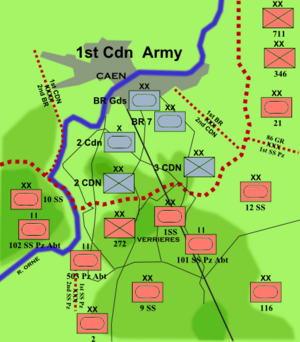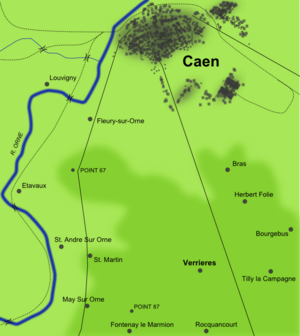Battle of Verrières Ridge facts for kids
Quick facts for kids Battle of Verrières Ridge |
|||||||
|---|---|---|---|---|---|---|---|
| Part of Operations Atlantic and Spring | |||||||
 Canadian soldiers under fire near Fleury-sur-Orne in the early hours of 25 July 1944 |
|||||||
|
|||||||
| Belligerents | |||||||
| Commanders and leaders | |||||||
| Strength | |||||||
| 2 Infantry Divisions, 1 Armoured Brigade |
2 Panzer Divisions remnants of 1 Panzer Division 1 Infantry Division |
||||||
| Casualties and losses | |||||||
| 800 killed 2,000 wounded or captured |
Unknown | ||||||
| Discussed in detail in Casualties | |||||||
The Battle of Verrières Ridge was a series of fights during the Second World War. It happened as part of the larger Battle of Normandy in France. Canadian and British soldiers fought against German forces. The battle took place from July 19 to 25, 1944. It was part of two bigger operations called Operation Atlantic and Operation Spring.
The main goal for the Allies (Canada and Britain) was to capture Verrières Ridge. This was a high area of land that controlled the road from Caen to Falaise. German soldiers, who were very experienced, had set up strong defenses there. For six days, Canadian and British forces tried many times to take the ridge. But the Germans defended it very well and launched strong counterattacks. This led to many Allied casualties with little success.
For the First Canadian Army, this battle is remembered for some mistakes in planning. One very difficult attack was made by The Black Watch (Royal Highland Regiment) of Canada on July 25. Out of 325 soldiers, 315 were killed, wounded, or captured. This was the most costly day for a Canadian battalion since the Dieppe Raid in 1942. Even though the Allies didn't fully capture the ridge, the battle helped another important operation. It kept powerful German tank divisions busy, so they couldn't stop the very successful Operation Cobra by the Americans.
Contents
Why Verrières Ridge Was Important
Verrières Ridge is about 8 km (5.0 mi) south of the city of Caen. It overlooks wide plains and controls the land between Caen and Falaise. Capturing this ridge was a key goal for the Allies on D-Day. However, the Allied advance was stopped before Caen, and the fighting became very slow.
On July 9, Operation Charnwood captured the northern part of Caen. But German forces still held the rest of the city. A week later, Operation Goodwood pushed the British forward, and Caen finally fell on July 19. By this time, the city was mostly destroyed. The next goal for the British and Canadians was the town of Falaise. But Verrières Ridge stood in their way. It was now strongly defended by German tank divisions. British forces managed to get a small hold on the ridge but couldn't remove the German defenders.
Who Fought at Verrières Ridge
The Canadian II Corps, led by Lieutenant-General Guy Simonds, sent two infantry divisions and one armoured brigade to attack the German positions. The Canadian 3rd Infantry Division, which had already suffered many losses, played a supporting role. The main attack was carried out by the Canadian 2nd Infantry Division. They were new to fighting but had tanks from the Canadian 2nd Armoured Brigade.
Later, more forces joined from the British I Corps. These included the 51st (Highland) Division, the Guards Armoured Division, and the British 7th Armoured Division. Even though the British units had more fighting experience, they played a smaller part in this battle.
On the German side, parts of the I SS Panzer Corps had made Verrières Ridge their main defense line. The ridge wasn't very high, but its shape meant that attacking soldiers would be exposed to enemy fire. Germans could shoot from across the River Orne, from the ridge itself, and from a nearby industrial village called St. Martin. The 12th SS and 1st SS Panzer Divisions held the ridge. They had artillery, hidden Tiger tanks, and mortar positions. The 9th SS Panzer Division was kept ready as a backup. Other German units, like the 272nd Grenadier Infantry Division and the 116th Panzer Division, also provided support.
The Battle Unfolds
First Attacks by Calgary Highlanders
After Operation Goodwood on July 19, the Calgary Highlanders tried to take the northern part of Verrières Ridge. But heavy German mortar fire stopped them. Tanks from the Sherbrooke Fusiliers helped by destroying several machine-gun positions. The Highlanders managed to dig in, despite enemy fire. Over the next few hours, they made their position stronger. Other Canadian brigades tried to push forward but were pushed back by strong German defenses. They suffered many losses. General Simonds quickly planned a new attack for the next day. The goal was to capture the eastern side of the Orne river and the main slopes of Verrières Ridge.
Operation Atlantic: A Tough Fight
The next attack, part of Operation Atlantic, happened on July 20. It was led by the South Saskatchewan Regiment, with help from the Queen's Own Cameron Highlanders of Canada. Early on July 20, the Camerons secured a spot in Saint-André-sur-Orne. But German soldiers and tanks quickly trapped them.
At the same time, the South Saskatchewan Regiment moved up the slopes of Verrières Ridge. They had support from tanks and Hawker Typhoon aircraft. However, heavy rain made the ground muddy and made air support useless. German counterattacks by two tank divisions pushed the South Saskatchewans back. Their supporting battalion, the Essex Scottish, also came under attack.
The Essex Scottish lost over 300 men trying to stop the 12th SS Panzer Division. By the end of the day, the South Saskatchewans had 282 casualties, and the ridge was still held by the enemy. Despite these problems, Simonds was determined to take Verrières Ridge. He sent in the Black Watch of Canada and the Calgary Highlanders to help. These battalions managed to stop German tank formations. By the time Operation Atlantic ended, Canadian forces held a few small positions on the ridge. But four German divisions still controlled the main ridge. In total, Operation Atlantic caused over 1,300 Allied casualties around Verrières Ridge.
Operation Spring: A Costly Push

After Caen was captured on July 19, the Allies could try to break out of Normandy. In the American sector, Lieutenant General Omar Bradley was planning his own breakout, called Operation Cobra. Simonds also started planning a new attack, named Operation Spring. This operation was first meant to keep German forces busy while Operation Cobra happened. But on July 22, after Operation Atlantic failed, Simonds changed Operation Spring's goal to a full breakout. If Verrières Ridge was taken, Simonds could launch tank and artillery attacks from its southern side. This would clear the Caen-Falaise road, allowing his two British armoured divisions to advance south.
Operation Spring was planned in four stages. The Calgary Highlanders would attack Bourguébus Ridge and May-sur-Orne to protect the sides of the main attack. The main push would be on Verrières Ridge by the Black Watch, with tank support. The attack was supposed to start on July 23, but bad weather delayed it for 48 hours. The Germans used this time to bring in more soldiers and tanks to reinforce the ridge. Allied intelligence knew about these reinforcements.
On July 25, Operation Spring began. The Black Watch was supposed to start their attack around 5:30 AM. But they met strong German resistance and didn't reach their starting area until almost 8:00 AM. By then, the Black Watch's two highest-ranking officers were killed. Command went to Major Phil Griffin. At 8:30 AM, he met with his brigade commander. Even though most of their promised tank support hadn't arrived, they decided to go ahead with the attack.
At 9:30 AM, as the Canadian soldiers advanced up the ridge, they were easy targets. German machine guns, mortars, tanks, and anti-tank guns fired heavily. To make things worse, the Black Watch's radios were knocked out quickly. Very few Black Watch soldiers made it to the top of the ridge. Those who did faced even heavier fire and German counterattacks. Out of 325 men who started the attack, 315 were killed, wounded, or captured. The Black Watch lost all its senior leaders, and two companies were almost completely wiped out.
What Happened After

All the ground gained by the Black Watch and Calgary Highlanders was lost to German counterattacks. These attacks caused heavy losses for both battalions. The Black Watch had to be rebuilt after Verrières Ridge. They had suffered more casualties than any Canadian infantry battalion since the difficult 1942 Dieppe Raid.
The central part of the ridge, near Verrières Village, was eventually taken and held by the Royal Hamilton Light Infantry. The east side was also taken but later lost. However, two British armoured brigades managed to secure important positions near the Royal Hamilton Light Infantry.
The failure to capture the ridge completely didn't greatly affect the overall Allied plan. This was because Operation Cobra was so successful. The Germans had to move many of their forces, including two tank divisions, away from Verrières Ridge to try and stop Bradley's American forces. With German defenses weakened, later Allied attacks on the ridge were successful. Operation Totalize finally captured the position from the German defenders on August 8.
Counting the Costs
The total number of Allied casualties for the entire battle isn't exactly known. But we can estimate by looking at the two operations. Operation Atlantic is believed to have caused 1,349 Allied casualties, with about 300 deaths. Operation Spring's losses were around 500 killed and another 1,000 captured or wounded. Based on these numbers, historians estimate about 800 Canadian soldiers died and 2,000 were wounded or captured. The Canadian soldiers who died are buried in the Bretteville-sur-Laize Canadian War Cemetery.
Historians say it's hard to know the exact number of German casualties. This is because their records were incomplete as the war went on. Also, units sometimes reported more losses than they had, hoping to get more backup.
German losses in the battle were much lower than the Canadians'. One German tank division lost about 1,092 men and some tanks in fighting across all its fronts, including Verrières. Another German tank division suffered only 134 casualties in all its areas during a similar time. Many of the German soldiers who died are buried at La Cambe German war cemetery.



